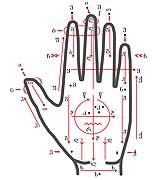Lorm alphabet
The Lorm alphabet is a method of tactile signing named after Hieronymus Lorm, who developed it in the late 19th century. Letters are spelled by tapping or stroking different parts of the listener's hand.[1] The Lorm alphabet is mostly used in German-speaking countries, the Netherlands, Czech Republic, Poland and Georgia.
Alphabet[edit]
- Lorm alphabet for German
- Lorm alphabet for Czech
- Lorm alphabet for English
- Lorm alphabet for Polish
- Lorm alphabet for Georgian
For the German language the following signs are used:
A Tap on the tip of the thumb B Short stroke on the index finger C Tap on the wrist D Short stroke on the middle finger E Tap on the index fingertip F Lightly squeeze the ends of the index and middle fingers G Short stroke on the ring finger H Short stroke on the little finger I Tap on the middle fingertip J Double tap on the middle fingertip K Tap with four fingertips on the palm L Long stroke from the end of the middle finger to the wrist M Tap on the base of the little finger N Tap on the base of the index finger O Tap on the ring fingertip P Long stroke on the outside of the index finger Q Long stroke on the outside of the hand (little finger side) R Light drumming of the fingers on the palm S Circle on the palm T Stroke on the thumb U Tap on the little fingertip V Tap on the ball of the thumb, slightly outside W Double tap on the ball of the thumb X Stroke across the wrist Y Stroke over the fingers in the middle Z Oblique stroke from the ball of the thumb to the base of the little finger Ä Double tap on the tip of the thumb Ö Double tap on the ring fingertip Ü Double tap on the little fingertip CH Oblique cross on the palm SCH Lightly grasping fingers II – V ST Long stroke on the outside of the thumb
Signals[edit]
The following signals may also be used:[2]
- Word ends can be signaled by a light tap on the palm.
- Word misunderstood or request to repeat can be signaled by closing the hand into a fist.
- Mistake by speaker can be signaled by rubbing the hand. The whole word must be repeated.
References[edit]
- ^ Marschark, Marc; Spencer, Patricia Elizabeth (2015). The Oxford Handbook of Deaf Studies in Language. Oxford University Press. p. 338. ISBN 9780190241414.
- ^ Białek, Maria, ed. (2009). Małymi krokami do wielkich celów: w świecie osób głuchoniewidomych (in Polish). Warsaw: Towarzystwo Pomocy Głuchoniewidomym. ISBN 978-83-925442-8-9. OCLC 751495670.


 French
French Deutsch
Deutsch



